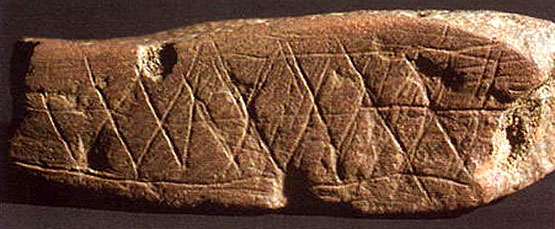|
|||||||||||||||||||||||||||||||
| The last glacial period was preceded by 1000 years of the coldest temperatures of the Late Pleistocene, apparently caused by the eruption of the Mount Toba volcano. The six year long volcanic winter and 1000-year-long instant Ice Age that followed Mount Toba's eruption may have decimated Modern Man's entire population. Genetic evidence suggests that Human population size fell to about 10,000 adults between 50 and 100 thousand years ago. The survivors from this global catastrophy would have found refuge in isolated tropical pockets, mainly in Equatorial Africa. Populations living in Europe and northern China would have been completely eliminated by the reduction of the summer temperatures by as much as 12 degrees centigrade. Volcanic winter and instant Ice Age may help resolve the central but unstated paradox of the recent African origin of Humankind: if we are all so recently "Out of Africa", why do we not all look more African? Because the volcanic winter and instant Ice Age would have reduced populations levels low enough for founder effects, genetic drift and local adaptations to produce rapid changes in the surviving populations, causing the peoples of the world look so different today. In other words, Toba may have caused Modern Races to differentiate abruptly only 70,000 years ago, rather than gradually over 0ne million years. |
|||||||||||||||||||||||||||||||
|
|||||||||||||||||||||||||||||||
| The Mount Toba eruption is dated to approximately 71,000 years ago. Volcanic ash from Mount Toba can be traced north-west across India, where a widespread terrestrial marker bed exists of primary and reworked airfall ash, in beds that are commonly 1 to 3, and occasionally 6 meters [18 feet] thick. Tambora, the largest known historic eruption, displaced 20 cubic kilometres of ash. Mount Toba produced 800 cubic kilometres.* It was therefore forty times larger than the largest eruption of the last two centuries and apparently the second largest known explosive eruption over the last 450 million years. *Mount St Helens produced a tiny 0.2 cubic kilometres. |
|||||||||||||||||||||||||||||||
|
|||||||||||||||||||||||||||||||
| Mount Toba's eruption is marked by a 6 year period during which the largest amount of volcanic sulphur was deposited in the past 110,000 years. This dramatic event was followed by 1000 years of the lowest ice core oxygen isotope ratios of the last glacial period. In other words, for 1000 years immediately following the eruption, the earth witnessed temperatures colder than during the Last Glacial Maximum at 18-21,000 years ago. For the volcanic aerosols to be effectively distributed around the earth, the plume from the volcanic eruptions must reach the stratosphere, a height greater than 17 kilometres. Mount Toba's plume probably reached twice this height. Most solar energy falls at low latitudes between the Tropics of Cancer and Capricorn, so eruptions that happen near the Equator cause much more substantial cooling due to the reflection of solar energy. Toba lies 2 degrees north of the Equator, on the Island Sumatra. The reduction in atmospheric visibility due to volcanic ash and dust particles is relatively short-lived, about three to six months. Longer-term global climatic cooling is caused by the highly reflective sulphuric acid haze, which stays suspended in the upper atmosphere for several years. Ice core evidence implicates Mount Toba as the cause of coldest millennium of the late Pleistocene. It shows that this eruption injected more sulphur that remained in the atmosphere fo a longer time [six years] than any other volcanic eruption in the last 110,000 years. This may have caused nearly complete deforestation of southeast Asia, and at the same time to have lowered sea surface temperatures by 3 to 3.5 degrees centigrade for several years. |
|||||||||||||||||||||||||||||||
 |
|||||||||||||||||||||||||||||||
| The Volcanic Winter/Weak Garden of Eden model proposed in this paper. Population subdivision due to dispersal within African and other continents during the early Late Pleistocene is followed by bottlenecks caused by volcanic winter, resulting from the eruption of Toba, 71 ka. The bottleneck may have lasted either 1000 years, during the hyper-cold stadial period between Dansgaard-Oeschlger events 19 and 20, or 10ka, during oxygen isotope stage 4. Population bottlenecks and releases are both sychronous. More individuals survived in Africa because tropical refugia were largest there, resulting in greater genetic diversity in Africa. | |||||||||||||||||||||||||||||||
 |
|||||||||||||||||||||||||||||||
|
|
|||||||||||||||||||||||||||||||
|
|
|||||||||||||||||||||||||||||||
|
Small and portable, this red ochre stone is engraved with what must be "tally" marks. It is one of two such stones recently found in the Blombos Cave in South Africa and have been dated as being 77,000 years old, making them the oldest form of recorded counting ever found. |
|||||||||||||||||||||||||||||||
|
|
|||||||||||||||||||||||||||||||
 |
|||||||||||||||||||||||||||||||
|
|
|||||||||||||||||||||||||||||||